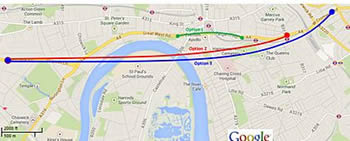Hammersmith Flyunder "Could Take Three Years to Build"
Comedian Bill Bailey backs tunnel plan's "enormous benefits"
A tunnel replacement for Hammersmith Flyover could take just three years to build and release around £1billion worth of former highway land to help pay for the works.
These are the key findings of Hammersmith & Fulham Council's "flyunder" feasibility study which was discussed at a transport select committee on February 12.
Following repeated closures of the 50 year-old flyover, council transport experts have worked with Channel Tunnel engineers Halcrow to explore ways of burying it and have come up with three possible options.

The alternatives vary from 1 mile to 2.5 miles long and are likely to cost between £218million and £1.7billion.
The shortest option would involve digging a "cut and cover" tunnel 15 meters beneath the surface between just opposite Furnivall Gardens in the west and Hammersmith & West London College in the east.
The advantage of this approach would be that 100% of the current 90,000 vehicles who use the Flyover every day would use the new tunnel. This option would also free up swathes of land currently occupied by the elevated A4 in Hammersmith Town Centre and remove Hammersmith's "Berlin Wall".
The second and third options for longer tunnels would both involve using tunnel boring machines, similar to ones currently being used to dig Crossrail, to burrow 25 metres underground. Both options would start at Sutton Court Road in the west with the second option emerging at North End Road and the third option – and longest tunnel – emerging at Earls Court Road.
Both longer tunnels would be twin bore, meaning there is a separate tunnel for each direction of traffic. However, the longer tunnels are likely to cost more than £1billion and less traffic would be likely to use them, according to the report.
Other key findings in the report show:
- 89% of respondents back some form of tunnel replacement
- Both long and short tunnels were found to be geo-technically feasible in the thick band of London clay beneath Hammersmith
- The degree to which Hammersmith Town Centre can be reimagined is partly dependent on the removal of the flyover but the severance caused by Hammersmith Gyratory would also need to be addressed
- Traffic analysis suggests the longer the tunnel is the less traffic is likely to use it
- The addition of north/south junctions would increase the use of an east/west tunnel use but considerable environmental and economic issues would also arise
Current estimates indicate that redevelopment on land freed up by a tunnel through Hammersmith town centre could achieve around £1billion – some of which could form part of the flyunder financing package.
As well as assisting in the delivery of an A4 tunnel, redevelopment could provide substantial benefits including new homes, jobs and improved open space. Better, more pedestrian and cycle-friendly connections between Hammersmith and the River Thames and opportunities to unravel the Hammersmith Gyratory could also be possible.
" This detailed report spells out three possible ways to replace Hammersmith Flyover with a flyunder,” says Cllr Nicholas Botterill, H&F Council Leader. " From a shorter tunnel that would act as a catalyst to transform our divided town centre to something longer stretching into neighbouring boroughs, we now know there are at-least three ways to tear down Hammersmith’s Berlin Wall.
" Each of the options has pros and cons but we are now clear that they are possible and, in some case, may even be self-financing – which is an important factor for taxpayers."
Hammersmith resident and popular comedian Bill Bailey, who attended the select committee, said: "I've lived in Hammersmith for 30 years and the traffic needs to be addressed. A flyunder would have enormous benefits for not just traffic but also for a much improved town centre environment."
The study, which will include feedback from the transport select committee, is set to be finalised by March 2014 - when it will be presented to Transport for London, which owns and manages the A4.
Cllr Botterill says: " This is only the beginning. There is still much work to be done and it is now up to TfL to use our report as a foundation and take the project through to the next stages of development."
To read the transport select committee report click here. Minutes of the meeting will appear shortly.
Meanwhile, TfL is continuing its works to repair the flyover with some overnight and partial closures of the flyover needed along as well as local road closures and diversions.
17 February 2014
